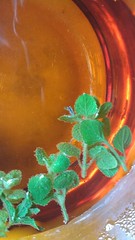When ardent students of mosses or bryologists traverse the globe to come to Tasmania, they will have, among the top candidates of their ‘to-see’ list, an endemic Tasmanian moss.
This is none other than Pleurophascum grandiglobum. Literally meaning: the bud-like Phascum moss with grand globes!
Rest assured that this moss lives up to it’s grandiose name. As this moss is so distinctive and significant, I’ll take the liberty to call it the Globe Moss, a name that I will use henceforth.
The moss was first described in the Journal of Botanyby an early bryologist, Sextus Otto Lindberg in 1875. He wrote (annotations in parentheses mine):
‘I Have to-day received from my friend Baron F. von Mueller, the renowned Director of the Botanic Gardens of Melbourne, a small tuft of a Moss, gathered this year by Mr. Robert Johnston on turfy soil near Picton River, in Tasmania. This Moss is of the highest importance, indeed of no less interest to the Muscologist (moss specialist) than is Rafflesia or Welwitschia to the Phanerogamist (higher plant specialist). It is, in fact, a very robust Phascaceous (bud-like) plant with the fruit perfectly lateral on the stem! I dare not as yet call it truly pleurocarpous (fruiting from specialized side branches), as its affinity is most obscure; but as it has, as far as I know, not been described, it ought to be called Pleurophascum grandiglobum…’
The Globe moss appears to be largely restricted to Buttongrass sedgeland habitats in the western part of the state.
The cup-like leaves are a beautiful study in spiral symmetry. When viewed from above the moss looks like lotus petals arranged around their flower axis. Combined with the additional habitatual context, these characteristics render the Globe moss difficult to mistake for anything else.
When this moss is in “fruit” however, it is most unmistakable!
The green spherical capsules, which ripen a dull yellow-brown, are a thumping 3-6mm in diameter (large for a moss!), and are possibly among the largest, if not definitely the grandest, of all mosses in Tasmania.
These grand structures that gives the moss it’s specific epithet ‘grandiglobum‘ are borne proudly on long setas (or stalks).
If there should one day be an international exhibition of mosses, where every country were to submit a portraiture of a unique indigenous moss for exhibition, there can be little doubt that the Globe moss will be the prime candidate to represent Tasmania’s bryological heritage.
As far as mosses go, the Globe moss puts Tasmania on the world map.








I took a casual 8 hour drive out to Gordon River road looking for this and found it! I was rather excited, the kids were too, because it meant we could stop searching roadsides in the rain for a moss!
LikeLiked by 1 person
Congratulations! I miss those pretty little thing. It’s great stuff for kids as well – like little green lollies on a stick. 🙂
LikeLike